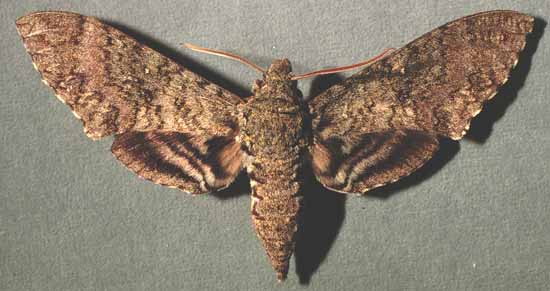Manduca sesquiplex opima
(Rothschild and Jordan, 1916)

Manduca sesquiplex opima male courtesy of Dan Janzen.
This site has been created by
Bill Oehlke at oehlkew@islandtelecom.com
Comments, suggestions and/or additional information are welcomed by Bill.
TAXONOMY:
Family: Sphingidae, Latreille, 1802
Subfamily: Sphinginae, Latreille, [1802]
Tribe: Sphingini, Latreille, 1802
Genus: Manduca Hubner, 1807 ...........
Species: sesquiplex opima Rothschild & Jordan, 1916
|
MIDI MUSIC
.....It's a Wonderful World.....
copyright C. Odenkirk
ON.OFF
<bgsound src="world.mid" LOOP=FOREVER>
|
DISTRIBUTION:
Manduca sesquiplex opima
(Wing span: (119 - 120 mm)),
flies in
Costa Rica, the specimen type locality:
Carthage, Puntarenas; and
in
Nicaragua: Jinotega, Matagalpa, Zelaya.
FLIGHT TIMES:
In Costa Rica there is probably only one generation annually with
moths on the wing in from September until November. In Nicaragua there appears
to be at least three flights, May, July, September.
ECLOSION:
Pupae probably wiggle to surface from
subterranean chambers just prior to eclosion.
SCENTING AND MATING:
Females call in the males with a
pheromone released from a gland at the tip of
the abdomen. Adults nectar at flowers.
EGGS, LARVAE, PUPAE:
Larvae probably feed on plants in
the nightshade family (Solanaceae).
Return to Sphingidae Index
Return to Sphingini Tribe
Use your browser "Back" button to return to the previous page.
This page is brought to you by
Bill Oehlke and the
WLSS. Pages are on space rented from Bizland. If you would like
to become a "Patron of the Sphingidae Site", contact Bill.
Please send sightings/images to Bill. I will do my best to respond to
requests for identification help.
Enjoy one of nature's wonderments: Live
Saturniidae (Giant Silkmoth) cocoons.
 | 
Show appreciation for this site by clicking on flashing butterfly to the left.
The link will take you to a page with links to many insect sites. |


